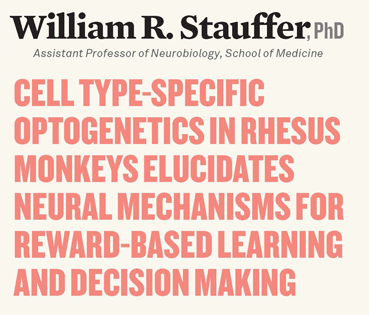
*Unable to make it to Scaife Hall? Dr. Stauffer’s lecture will be available via live stream to people with Pitt login credentials by clicking this link (sign in using your Pitt username and password): https://pitt.hosted.panopto.com/Panopto/Pages/Viewer.aspx?id=6bb191a5-6992-4b23-a013-4d6238b5d35a. If you have problems with the video, contact the CSSD help line at 412-624-4357 (4-HELP). Viewers can participate in the post-lecture Q&A by clicking on the “Discussion” tab and posting a question in the comment box.
Topic Overview:
A cube of sugar, the opening notes of Beethoven’s Fifth Symphony, and the paper bills we call “money” have very little in common. They are not made of the same physical stuff, and there is no ruler that can effectively compare them. Even biophysically, they enter our awareness via distinct pathways that share no common receptors. And, yet, we readily recognize them all as rewards and exchange one for another. Stauffer’s research is dedicated to understanding how the brain accomplishes these poly-sensory and multidimensional feats. In his lecture, Stauffer will introduce dopamine neuron physiology and reward prediction error coding. Dopamine neurons code for the difference between received and predicted rewards. The magnitude of dopamine neuron responses scale with the economic value (utility) of this difference. Stauffer will describe how we measure utility, the neural evidence that dopamine prediction error responses reflect this economic concept, and describe new experiments that investigate these signals in terms of information availability. Stauffer will also discuss the application of optogenetic technologies to nonhuman primates (NHP). Optogenetics and other next-generation molecular technologies are largely dependent on genetically modified small animal lines. Therefore, they are not broadly applied to NHP studies. This prevents their application to the most relevant animal model that is available for studying human cognition and disease. Stauffer and colleagues have developed the use of cell type-specific promoters and a combination of viral vectors to drive the expression of channel-rhodopsin in NHP dopamine neurons. Cell type-specific optical stimulation of dopamine neurons resulted in the neural and behavioral correlates of value. Stauffer will discuss how we are expanding this technology to other neuron types to study diverse aspects of decision making and behavior.














